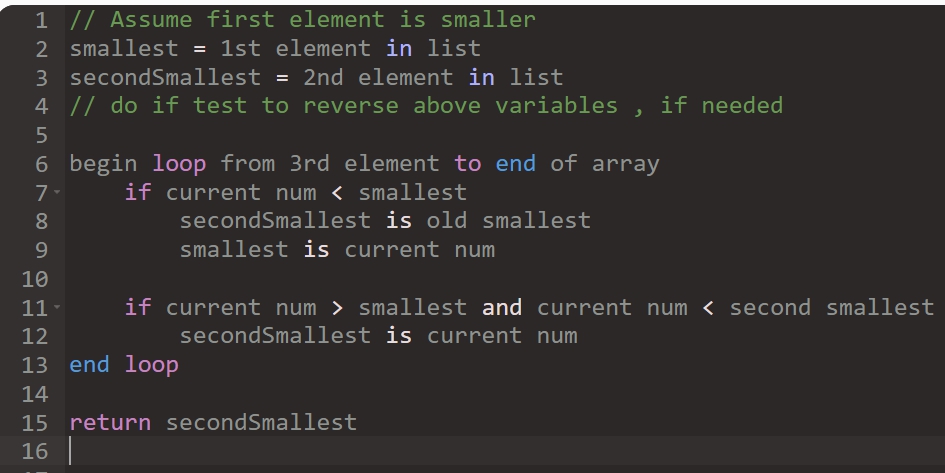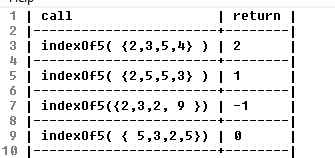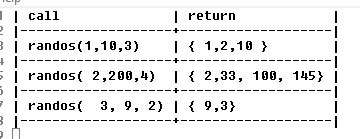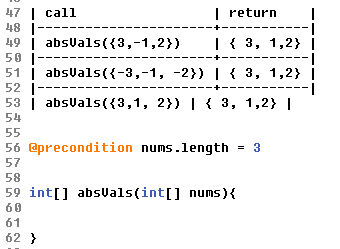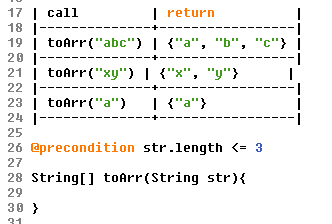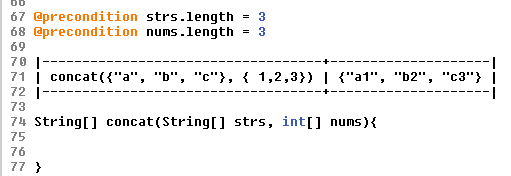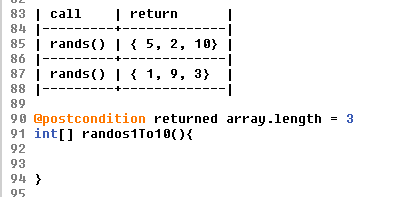Tag Archives: array
Array Fun 2 [2023]
Complete all the methods below. When you are done, copy and paste the testmethods.v5.1 into your class and run it to see if you have any obvious errors. The above code does not guarantee you a 100 but will help catch most of the common errors that students make.
Note: You may not use any external libraries (like Java.Arrays etc )or import any code. Everything can be done with just loops and variables.
int sumEveryN(int[] nums, int n)
Description:This method returns the sum of every n elements of nums ..
| Method Call | return value/output |
| sumEveryN( {1 , 2 , 3 , 4 }, 2 ) | 4( ie 1 +3) |
| sumEveryN( {13 , 42, 15, 33 , 44 , 16 , 52} ,3) | 98 ( ie 13 + 33+ 52) |
String[] doubleArr(String[] strs)
Description: This method returns a new version of strs in which each element now appears twice. This can be done with a for-each loop, which I believe is easier and more intuitive.
| Method Call | return value/output |
| doubleArr( {“a”,”b”,”c”} ) | {“a”,”a”,”b”,”b”, “c” , “c”} |
| doubleArr( {“math”,”ware”,”house”,”.com” }) | {“math”,”math”,”ware”,”ware”,”house”,”house”,”.com”, “.com”} |
int indexOf5(int[] nums )
Description:This returns the index of the first occurrence element 5 or -1 if 5 does not appear anywhere in the array.
| Method Call | return value/output |
| indexOf5( { 2 , 3 , 5 , 4 } ) | 2 |
| indexOf5( { 2 , 3 , 5 , 4, 5 } ) | 2 |
| indexOf5( { 2 , 3 ,7 , 4, 3, } ) | -1 |
More Sample calls and return vals
int indexOf(int[] nums, int num)
Description: This method returns the index value of the first appearance of num or -1 if num is not an element of nums .
| Method Call | return value/output |
| indexOf( {6,4 ,7,3, 4 }, 4) | 1 |
| indexOf( {6,4 7 ,3,2,7}, 7) | 2 |
| indexOf( {6,4 ,2,3}, 22) | -1 |
int[] randos(int start, int end, int howMany)
Description: This method returns an array of random numbers between [start,end] . Note make sure that each element in the new array attempts to make a new random int. Use Math.random() , do not use any other mechanism for finding a random number.
double meanBetween(int[] nums, int min, int max)
Description: This method returns the mean of nums ; however, this method only counts values within the range (min,max) as shown in the examples below:
int secondSmallest(int[] nums )
Description: This method returns the element of nums with the second smallest value.
Note: You may not modify the input array. For instance, you may not put nums in order, which would be bad because you were not asked to modify the array.
@precondition: nums.length >= 2
Note: You will lose credit if you use a constant to represent the smallest or second smallest number. See pseudocode
| Method Call | return value/output |
| secondSmallest( { 2 , 18 , 22, 4 , 6 } ) | 4 |
| secondSmallest( { 3 , 7 , 15 , 1 ,101} ) | 3 |
boolean isPalindromic(int[] nums)
Description:This method returns true if the elements of nums are a palindrome.
| Method Call | return value/output |
| isPalindromic(( { 5 , 2, 7 , 2 , 5} ) | true |
| isPalindromic( { 5 , 2, 7 , 3 , 5} )) | false |
| isPalindromic(( { 1 , 2, 1} ) | true |
Old versions:
String 1 and Array 1 Exercises
Exercises for String 1 and Array 1 (no loops)
When you are done, you can copy and past the score() method below into your class. It will test some (but, by no means all) of the things that your code should do
Create a class called StrArr1 and add each method below into it.

For the absVals() method below use the Math.abs() Java method.
For the randos1to10() method below use the Math.random() Java method. Create a new array to store random integers. Each integer should be [1,10]
Class Roster Array Version [Java] Assignment
Class Roster: This class will implement the functionality of all roster for school. It will , in essence, manage an Array of Student objects. Each roster will store a default of 10 Students
- “global” Instance Variables
- private Student myStudents : an array storing Student Objects
- private String className (a name to represent a given roster like “Ap CS”)
- public int period //during which period of the day does this roster meet
- a default constructor should initialize the Array to store 20 strings
a single parameter constructor that takes an Array <String>
Both constructors should initialize the instance variables - Methods
- Accessors
- private int indexOf(Student st) //@returns index of Student St or -1
- public boolean containsStudent(Student studentName )/ /@returns true if studentName is in roster .
- public boolean equals(ClassRoster other) //@ returns whether or not rosters are equal. Rosters are equal if identical students are in identical order in the lists
- Mutators:
- Accessors
|
1 |
boolean addStudent( Student st ) ;//adds the student to the Roster |
public void addStudent(String studentName, int age) ;// adds student name and age to end of roster
. Hint: Make user of the containsStudent() method
public boolean removeStudent(int ssnId ) // removes student from roster based on id. Make sure that you maintain the integrity of the parallel ArrayLists.
public boolean removeStudent(String name) //removes student based on name. Make sure that you maintain the integrity of the parallel ArrayLists.
public boolean removeStudent( Student st) //removes student st. Make sure that you maintain the integrity of the parallel ArrayLists.
Student Object (OOP Java)
Student Class
A school district decided to write a program to help keep track of various parts of the school.
It has been decided to store relevant information about Students in a Student class. Each Student will have an array of Strings to store the names of his or her teachers.
private instance variables
|
1 2 3 4 5 6 7 8 9 10 11 12 13 14 15 16 17 18 19 20 21 |
public class Student { public String name; private int age private double gpa; private //insert array declaration; public Student(){} // default constructor boolean setTeacher (String name, int index){ //missing code } public void setGpa(double to){ //missing code } public double getGPA() // returns gpa } |
Part 1
* Construct the Java statement to declare the array called
teachersNames to store the String names of the student’s teachers
Part 2
- write a default constructor
- construct a method called
addTeacher( String name) that adds
String name to the
teachersNames array
- to do this let’s create a private method private String[] addStr( String[] input, String val) that adds value to the end of the array and returns it. [redact]Solution[/redact]
- construct hasTeacher(String name) that returns true if name is in the teachersName array
- construct a method removeTeacher(String name) that removes the String name from the teachersNames array.
- construct a method the line of code needed in the setGpa(double to) method of the Student Class.
- construct a method boolean setTeacher (String name, int index) . This method should return true if index is valid in the array and false if index >= teachersName.length
Array Fun 2
Java Assignment
![]() Create a Class called
ArrayFun2 that has the following methods Write the body for the methods described below.
Create a Class called
ArrayFun2 that has the following methods Write the body for the methods described below.
|
1 |
int[] digitsToArray(int num) |
Description: This method creates an array that is filled with all of the digits of
nums.
| Method Call | return value/output |
| digitsToArray( 523 ) | {3, 2, 5} |
| digitsToArray(1267 ) | { 7 , 6 , 2, 1 } |
public boolean allFactorsOfSum(int[] nums)
Description: This method returns true if each element of
numsis a factor of the sum ofnums.
| Method Call | return value/output |
| allFactorsOfSum( {6,1,2,3} ) | true (because all of the elements are factors of the sum which is12) |
| allFactorsOfSum( 1,4,7) | false (because 7 is not a factor of the sum of this array which is 12) |
public String[] doubleArr(String[] strs)
Description: This method returns a new version of
strswith each element appearing twice.
| Method Call | return value/output |
| doubleArr( {“a”,”b”,”c”} ) | {“a”,”a”,”b”,”b”, “c” , “c”} |
| doubleArr( {“math”,”ware”,”house”,”.com” }) | {“math”,”math”,”ware”,”ware”,”house”,”house”,”.com”, “.com”} |
public boolean isThere(int[] nums, int num)
Description: This method returns true if
numis an elementnums.
| Method Call | return value/output |
| isThere( {6,1,2,3}, 6) | true |
| isThere( {6,1,2,3}, 5 ) | false |
public int indexOf(int[] nums, int num)
Description: This method returns the index value of the first appearance of
numor -1 ifnumis not an element ofnums.
| Method Call | return value/output |
| indexOf( {6,4 ,7,3, 4 }, 4) | 1 |
| indexOf( {6,4 7 ,3,2,7}, 7) | 2 |
| indexOf( {6,4 ,2,3}, 22) | -1 |
public int lastIndexOf(int[] nums, int num)
Description: This method returns the index value of the last appearance of
numor -1 ifnumis not an element ofnums.
| Method Call | return value/output |
| lastIndexOf( {6, 4 ,7 ,3, 11, ,4}, 4) | 5 |
| lastIndexOf( {7, 6,4 , 7 ,3}, 7) | 3 |
| lastIndexOf( {6,4 ,2,3}, 22) | -1 |
public boolean isIncreasing(double[] nums)
Description: This method returns true if each element in nums is greater than the element to its left.
| Method Call | return value/output |
| isIncreasing( {1,2,3,4 }) | true |
| isIncreasing( {1,0 ,3,4 }) | false |
| isIncreasing( {1,1, 2,3,4 }) | false |
public int largestSpan(int[] nums)
Description: This method returns the largest span of consecutive increasing numbers
| Method Call | return value/output |
| largestSpan( {4, 3, 1, 2, 3 , 1} ) | 3 |
| largestSpan( {4 , 3, 1 , 12 , 31 , 44 , 52 , 1} ) | 5 |
| largestSpan( {9, 7, 8 , 12,4, 3, 0, 4 , 1) | 3 |
| largestSpan( {1, 0, 4, 5 , 3, 2, 8 , 9, 10, 12, 4, 3, 1 }) | 5 |
** int[] invert(int[] nums)
Description: This method ‘inverts’ an array by spliting the array in halves and ‘inverting’ each half. See sample calls to understand.
| Method Call | return value/output |
| invert( {5 , 21, 5, 13,4 }) | {4, 13, 5, 21, 5 } |
| invert( { 1, 2, 3, 4, 5,6 }) | { 6, 5, 4, 3, 2, 1} |
** int[] shiftByN(int[] nums, int delta)
Description: This method returns the array with all digits shifted by
delta. Any digits that are circulated off the end of the array should be returned to the other side. Note: delta could be positive or negative. Please keep in mind that Math.abs(delta) > nums.length could be possible 😉
| Method Call | return value/output |
| shiftByN( {5 , 21, 13,4 } 1) | { 4 , 5 , 21, 13 } |
| shiftByN( {5 , 21, 13, 4 , 11} 2) | { 4 , 11 , 5 , 21, 13} |
| shiftByN( {5 , 21, 13, 4 } -1) | { 21, 13, 4 , 5} |
| shiftByN( {5 , 21, 13, 4 ,7 } -2) | { 13, 4 ,7 , 5 , 21} |
1 < base < 11@precondition
num1.length = 5 and num2.length = 5@postcondition: the returned array has 5 elements representing the sum or an ArithmeticException is thrown
Description: This method attempts to replicate addition. Consider both num1 and num2 represent the five digits of a number. Each element in the array stores one of the digits. For instance, the number 143 would be represented as {0,0,1,4,3 }. Numbers can be in any base between 2 and 10 inclusive , and the number 101102 in binary would appear in an arrays as : {1, 0, 1 , 1, 0 } . Let’s assume the numbers are positive.You should return an array representing the digits of the sum of num1 and num2. If the number of digits in the sum exceeds the maximum number of digits (5) , you should throw an arithmetic exception as shown in the code below:
Note: You may not use any kind of helper or utility methods that are built into pre-defined Java classes for converting numbers between bases. Only use techniques taught in this class.
| Method Call | return value/output |
| add( {0,0,0 ,4,2},{0,0,0,5,1}, 10) | {0, 0, 0, 9, 3} ie (42 + 51 = 93) |
| add( {0, 0, 0 ,7,2},{0,0,0,5,1}, 10) | {0, 0 , 1 , 2, 3} ie (72 + 51 = 123) |
| add( {0, 0 , 0 , 1 , 1}, { 0 , 0 , 0 , 1 }, 2) | {0, 0 , 1 , 0 , 0} ie ( 112 + 12= 1002 ) |
